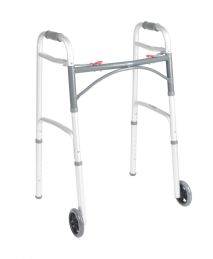

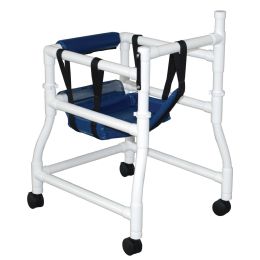
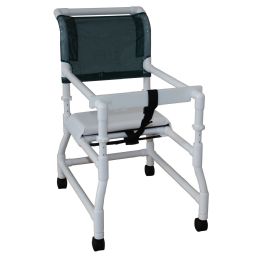
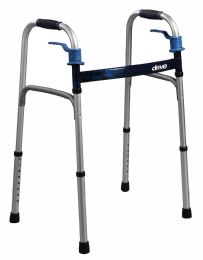


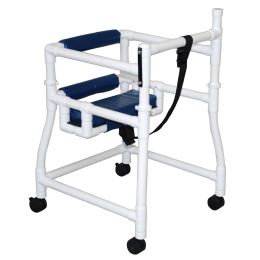
What is a Walker?
A walker is a medical device that has a basic design consisting of a lightweight frame usually made from aluminum and is waist high, about 12 inches deep and slightly wider than the user. Walkers come in various sizes such as pediatric sizes for children or bariatric sizes for large adults, and many are height adjustable. The height of the walker should be set at a height where the user can have a slight bend in his arms when walking (about hip high) with a walker to allow for proper blood circulation through the arms and a safer balance for the user. The front two legs of the walker may or may not have attached wheels, depending on the strength, balance and abilities of the user. Glides, caster wheels or even tennis balls with a hole cut into them may be attached to the back legs of a walker to offer a smooth gliding support when walking on hard surfaces such as linoleum, epoxy and hardwood floors often found in institutions and private homes.
There are different types of walkers; some have no wheels, while others have two wheels or four wheels. Many walkers can fold-up for easy transportation or storage, while some walkers have baskets, a sitting bench, or brakes (for wheeled walkers).
Some variations of walkers are known as hemi walkers, rollators, and gait trainers.
Hemi walker – also known as side walkers, are about half the size of a traditional walker. A hemi walker is intended for the use by individuals with limited dexterity or the non-existent use of one hand or arm. When using a hemi walker, the user will use it much like a cane, leaning on the hemi walker to the side of the user and using one arm on the hemi walker for balance when walking. The hemi walker is more stable than a standard cane or a quad cane.
Rollators – a rollator is a more sophisticated version of a walker with wheels. They are usually height adjustable and lightweight, yet are sturdier than a conventional walker. Having three or four large wheels, handlebars equipped with hand brakes to instantly stop the rollator, and a built-in seat which allows the user to stop and rest, rollators are used by individuals who are more capable of movement and have good balance and strength but still require assistance when walking.
Gait trainer – intended to provide the opportunity to improve the walking ability of physically disabled children and adults, a gait trainer is a wheeled medical device that offers both postural alignment and non-weighted support to help individuals to walk independently or to learn/re-learn to walk safely and efficiently. Functionally similar to a support walker, a gait trainer provides more assistance for weight-bearing and balance in a safe, supported position by stabilizing the pelvis to prevent falls, and providing partial support to allow the user to stand and walk without being helped up. A gait trainer can assist people with walking impairments due to some childhood medical conditions such as cerebral palsy or spina bifida, or later illnesses or accidents, to learn to walk again with repeated safe weight-bearing walking practice.
Who May Need a Walker?
Individuals with medical conditions such as leg or back injuries or surgery, or those who are unable to walk without help may require the use of a walker. Individuals with poor balance or coordination, lack of strength in their legs, at risk of falling, or who have unstable joints may need the use of a walker. Depending on the severity, cause or reason of an individual’s instability and balance, a person may use a walker for a short time during recovery and rehab, or he or she may need to use a walker permanently for support while standing and walking.
How to Use a Walker
Traditionally, a walker is picked up and placed a short distance in front of the user while the user provides support by holding the top of the sides of the walker frame. Users then step forward until they are even with the walker, and will repeat the process until they reach their goal. If wheels or glides are on the walker, the user can push the walker instead of lifting it, allowing for a quicker and smoother venture for those with little arm strength.
When using a walker, all four tips of the legs of the walker need to be on the ground before users put their weight on it to move forward. When walking with a walker, users should look forward and not down at their feet, and they should make sure that the handles of the walker are level with the hips, while elbows are slightly bent when holding the handles. This allows the strongest part of the arms to carry the weight while also allowing circulation into the un-locked arms.
When going from sitting to standing, the user should try to sit in a chair with armrests so to be able to push up from the chair by using the armrest for support. Users should place the walker in front of themselves with the open side facing them. Make sure all legs of the walker are resting evenly on the floor, then lean slightly forward and use the arms on the chair’s armrests to push up from the chair to stand up. Do not use the walker to help stand by pulling or tilting the walker, as this will cause an unbalanced foundation and can lead to falling. Once up, grab the handles of the walker and step into the walker. Before walking, the user should stand and feel steady before moving.
When sitting down while using a walker, the user should back up to the bed, chair or toilet until the edge of the seat touches the back of the user’s legs. While making sure all four legs of the walker are solidly touching the ground, the user should reach back with one hand and grab the chair armrest or edge of the bed. While lightly keeping one hand of the walker for balance, slowly sit down and then using both hands, slide back into a comfortable sitting position.
When stepping up or down onto or from a curb, users should place the walker in front of them, making sure all four legs are firmly grounded. They should then step up or down into the walker, using the stronger leg first, then putting all of their weight on the walker with their arms, users should then bring the weaker leg up to or down from the curb. Walker users should keep some space between themselves and the walker, with the toes staying just inside the walker, as stepping too close to the front of the walker may cause the walker to lean forward, resulting in loss of balance.
How to Prevent Falls Around the Home
Keep the floor clean of clutter and obstacles.
Wear shoes or non-skid slippers. Do not wear shoes with heels or shoes with slippery leather soles. Also do not wear socks or nylons without shoes or non-skid slippers.
Do not have loose rugs or unsecured power cords on the floor to get tangled up in, or any loose rug corners that stick up.
Make sure that the walker is safe by a daily check on the leg tips and wheels/glides.
Attach a bag or basket on the walker to hold items so that users can keep both hands free to use the walker safely.
Unless trained by a physical or occupational therapist, do not try to use the walker on escalators or stairs.
Hulet Smith, OT
Rehabmart Co-Founder & CEO
ws